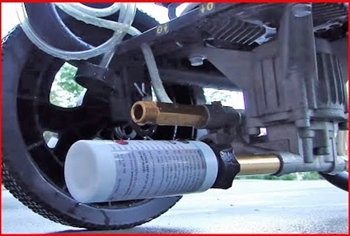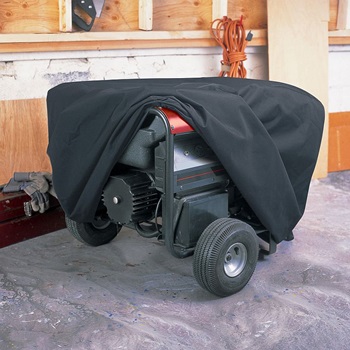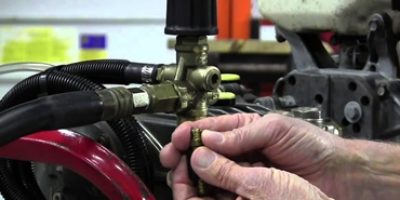When you are the owner of a pressure washer, you need to learn how to properly store the unit so that you may preserve its longevity. The chances are that during winter, you will not have to deal with any washing – so, in order to preserve the longevity and keep the warranty alive, you will need to store it in a proper manner.
Most user manuals will usually include a guide on how to winterize the unit – but in this article, you may find some details that are easier to understand. Depending on whether you have a gas pressure washer or an electric model, here is what you have to do in order to winterize them.
Quick Steps for Winterizing a Gas Pressure Washer
 If you don’t plan on using your gas pressure washer during the next 30 days, it is crucial that you undergo proper storage of the unit. You will need some fuel stabilizers, and you must also remove any liquids that are “sitting” in your unit.
If you don’t plan on using your gas pressure washer during the next 30 days, it is crucial that you undergo proper storage of the unit. You will need some fuel stabilizers, and you must also remove any liquids that are “sitting” in your unit.
Step 1: Add Fuel Stabilizer
When winterizing the pressure washer, it is important that you stabilize the gasoline – which means that you will have to add fuel stabilizer. This will prevent the gas from clogging the fuel lines during the time that it’s in storage. Once you have done that, you should run the engine for around 2 minutes, to ensure that the stabilizer is efficiently blended throughout the fuel system.
To play it even safer, you can drain the gas from the unit and place it in a gas can. However, don’t forget to add fuel stabilizer, lest the gas will crumple up – therefore becoming unusable when spring comes.
Step 2: Flush Away Remaining Water
If there is any water or detergent remaining in your unit, you will have to remove it. First, you should press the unit’s injection tube into a bucket that has clean water, running the pressure washer on a low setting. Run it for a minute or two before you turn off the water supply and the engine.
Once you have done that, give the spray gun trigger a squeeze so that the pressure trapped there can get out. Don’t forget to also set the lock. Once you disconnect and dry all the attachments, put them away in a dry place. Bear in mind that the pump may still have some leftover water – but this can be removed by simply pulling the recoil handle a couple of times.
Step 3: Add the Pump Saver
Aside from fuel stabilizer, you will also need some pump saver. This will prevent the moisture from building up in the pump – therefore, ensuring that it will not freeze in low temperatures. Since it also prevents the development of minerals, it will allow the engine to start quickly after a long storage period.
The pump saver should be applied through the inlet of the garden hose, allowing it to fill the chamber. You should leave it there the whole winter, and then take it out once spring turns a corner and you plan on using the unit.
Steps for Winterizing an Electric Pressure Washer
Once you have addressed our electric pressure washer buying guide and bought your unit, you will also need to maintain it. The process for winterizing an electric pressure washer is similar to the process of winterizing a gas model. However, there are some differences. So, here are the steps that you need to follow in order to conduct proper winterizing of an electric unit.
Step 1: Clear the Remaining Water
Since there is no gasoline engine to stabilize, the second step of the gas model will be the first step of the electric one. Get a bucket of clear tap water, and place the hose for detergent suction in it. After that, attach the garden hose, after which you turn on the tap.
At this point, you should turn the pressure washer on for about two minutes. Press onto the spray gun trigger, and let the detergent spray out of the unit. Turn the pressure washer off, and disconnect the garden hose. Finish this step by pulling the gun again and emptying the power washer of any remaining water.
Step 2: Add the Anti-freeze Liquid
The last step is to protect the pump. Take some pump saver (or antifreeze, as it is also called), and let it enter the pump through the inlet. This will prevent the inner seals from freezing.
Store the electric pressure washer in a warm and dry place, to prevent it from humidity and freezing. This way, it will be much easier for you to turn the engine on when winter comes to an end.
Further Tips for Winterizing Your Pressure Washer
 No matter if they are gas washers or pressure washers, there are some tips that apply to both units. This is how you ensure your power washer survives through the winter.
No matter if they are gas washers or pressure washers, there are some tips that apply to both units. This is how you ensure your power washer survives through the winter.
1. Store It in a Correct Place
When winterizing your pressure washer, you need to ensure that you store it in a suitable place – away from the wrath of Mother Nature during winter. Ideally, you should store it in a warm and dry place – for example, in your basement or garage. If those places are too humid or cold, you might want to find a better place for them in your home.
2. Use a Storage Cover
Many people believe that, since the pressure washer is stored indoors, you will not need to cover it with anything. However, without a storage cover, the pressure washer will fill up with rust and dust. This might enter its system, and compromise the way in which it will work.
Final Thoughts
Winterizing your pressure washer is essential – and while it might take a few good moments, it will be worth it. In the end, this will prolong the longevity of the unit, as well as its guarantee.
Remove anything that has to be removed from the unit – and add the proper solutions to get it through the winter. Considering that a pressure washer is such an expensive investment, you don’t want to ruin it due to poor maintenance. For more tips, you may want to visit our homepage.

